My first task this morning is to catch the 7am bus back to Llanfaethlu and reclaim my car, then I drive to Amlwch and park near the port. Another bus takes me back to Cemaes. I am the only passenger. The driver recognises me and we have a good chat.
I leave Cemaes with regret, having really enjoyed the time I spent here. The harbour is pretty and there are thriving shops, a number of pubs, and a buzzing atmosphere.

I see a strange object on the beach. St Patrick’s Bell, says a sign, but doesn’t give any other information about it.
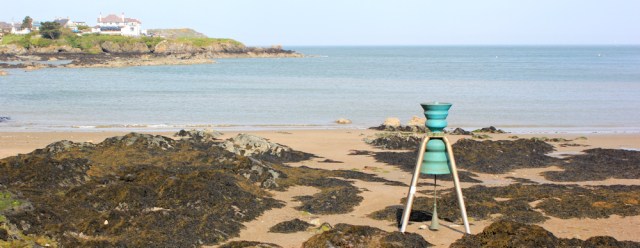
[Later I learn this is one of a series of tide-rung bells installed around the shoreline of the UK as part of an art installation project by Marcus Vergette, called Time and Tide. There is a bell at Aberdyfi too, which I missed when I walked through that town as it’s hidden under the pier. And another one at Appledore, north Devon, which I also missed seeing.]
I climb up above the beach and walk around the headland. It’s a popular area with several strollers and dog-walkers. Across the bay is Wylfa Head, looking deceptively near, and the chunky buildings of the power station.
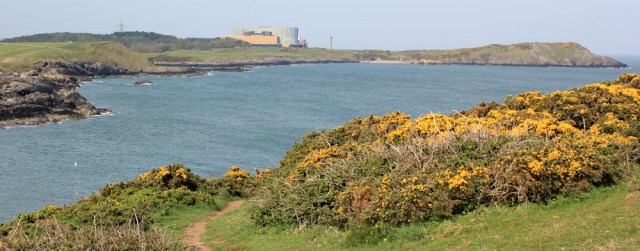
I soon leave the dog walkers behind as I follow the path, heading towards the bay of Porth Padrig.

In Porth Padrig there are some amazing rock formations. I’m still staggered by how varied the geology of this area is.
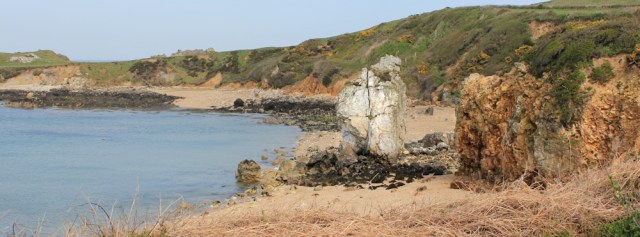
Anglesey lies on a fault zone in the tectonic plates, leading to an astonishing jumble of sedimentary, volcanic and metamorphic rocks. In places the older layers lie on top of younger ones – a confusing phenomena called ‘mélange’ – caused by the scraping action of one tectonic plate against another.
I walk around Llanbadrig Point, and past a little chapel and graveyard. Ty’n-llan.
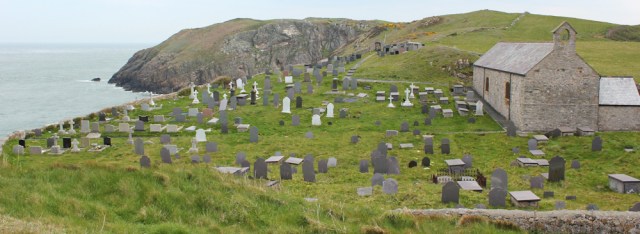
The next section of walk is one of the best on Anglesey, in my opinion. It is as scenic and unspoilt as South Stack, but with far fewer visitors.
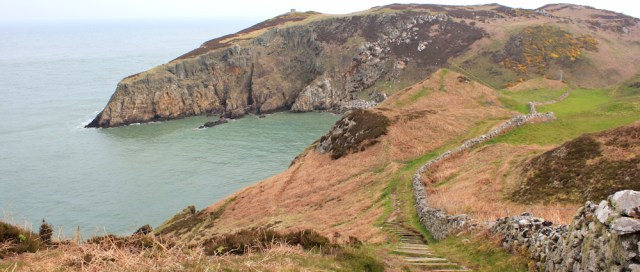
In a small valley I find a set of ruined buildings set at the apex of a small bay. This is Porth Llanlleiana, and the ruins are the remains of Llanlleiana porcelain works.

It’s sad to see how much industry we have lost from this area.
Out to sea is the most northerly point of Wales: Middle Mouse Island (or Ynys Badrig). It’s supposed to be the place where St Patrick was once shipwrecked, which is how the St Patrick’s Bell in Cemaes got its name.

But the island is just a lump of rock and inaccessible. So the most northerly point I can actually reach is Llanlleiana Head, where there are the ruins of a small watchtower. It’s a lovely spot and I linger to take photographs.

After leaving Llanlleiana Head, the path dips like a rollercoaster. In fact, this turns out to be one of the toughest stretches on the Anglesey Coast Path, and I’m pleased I didn’t attempt to complete this section yesterday.

Climbing up onto the next headland involves a bit of a scramble. When I reach the top the views are lovely. There’s Ynys Badrig (Middle Mouse) peeking out from behind Llanlleiana Head. And below is a narrow bay called Porth Cynfor, or Hell’s Mouth.
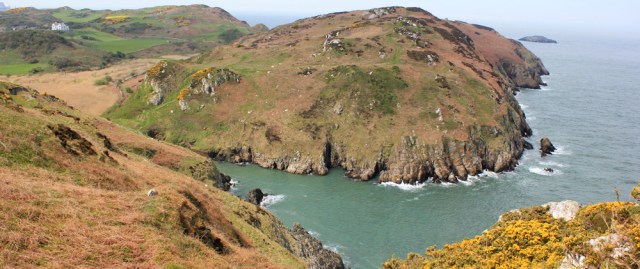
It’s not the first Hell’s Mouth I’ve come across. I remember the Hell’s Mouth where I nearly froze to death on the Llyn Peninsula. This one looks far less intimidating. I try to imagine it cold and windy, with a raging sea.
Onwards. I meet a few other walkers on the path now, coming towards me. Some wearing flip-flops, others sandals. I wonder how they will cope with the rugged path down to Hell’s Mouth.
Ahead is Porth Wen and the high headland of Torllwyn. Perched on top are some radio masts. The coast path doesn’t climb the headland, for some reason, but I can’t resist going up to the top.
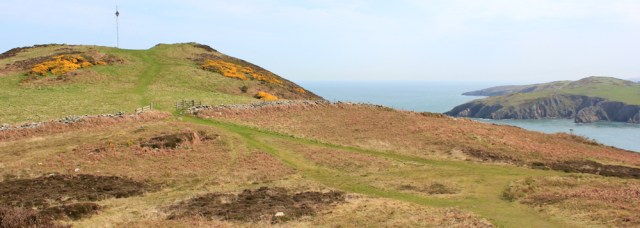
I stop on the high point for a drink and a snack, and then set off downwards and make my way around Porth Wen. Here are more abandoned industrial buildings. This time it’s a brickworks. What a fantastic location.

Beyond Porth Wen the path passes along the slopes of Mynydd Pantygaseg, an easy walk through grass and gorse, punctuated by rocky outcrops. Ahead I can see buildings. Amlwch?

I spot a nest hanging on the cliffs below. I was expecting seagulls, but am startled to see large black chicks. Rooks? Crows? They look too chunky to be choughs, but it seems an unusual place for a non-seabird to nest.

It’s time to swap over maps. I put away OS 262 and pull out OS 263. Oh, it’s not Amlwch I’m looking at. I’m getting ahead of myself. It’s Bull Bay.
As I approach Bull Bay, I notice a house perched right on the water’s edge, with its foundations seemingly embedded in solid rock. What a wonderful place to live. But perhaps rather frightening on a stormy winter’s night.
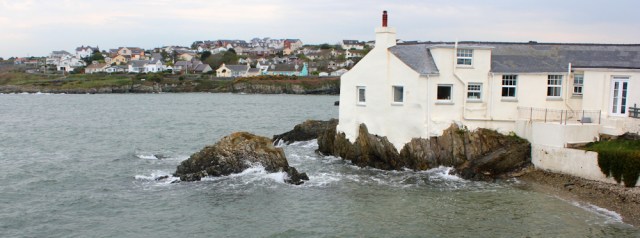
I stop at the first pub I come to in Bull Bay – grandly called The Bull Bay Hotel – but it’s rather faded. In fact, downright shabby. They were just about to stop serving meals, but make me a prawn cocktail. I’m the only customer.
After lunch I continue walking around Bull Bay. There is strip of grass and gardens close to the sea, but they are ‘private’, so I’m forced to walk along the road. At least there is a pavement.

At the end of the bay I can leave the road and strike off down the coastal path. Here I meet other walkers, amblers and dog walkers. Ahead…? That really must be Amlwch.

This is a pleasant walk with the path gently rolling across the top of the low cliffs. On the way I meet three serious walkers – young lads with giant backpacks. They look hot and bothered. Exhausted. I wonder where they’ve come from and how far they’re planning to go.

One of the lads warns me about mud on the path. ‘It’s very slippery,’ he says. Later I find a little smear of mud, but nothing compared to some of the places I’ve walked through.
The approach to Amlwch is an odd mix of scenic rocks, burnt vegetation, and a looming mass of derelict buildings. That must be another abandoned industrial compound. This was once a centre for copper mining and ship building.

The path turns away from the shoreline, skirting around the industrial area. It’s an attractive walk, with bluebells lining the route

And then the path crosses over a disused railway line and circles around a residential area. Ahead is an old windmill, minus sails.
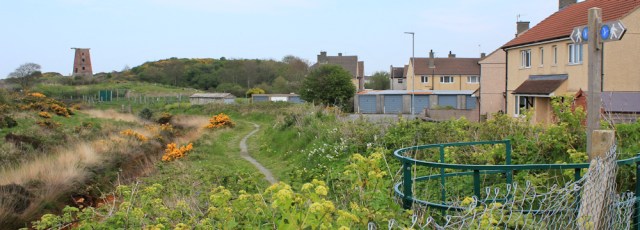
And, finally, I reach the harbour at Amlwch, an area called Amlwch Port. The tide is in and the boats are bobbing. Very pretty.
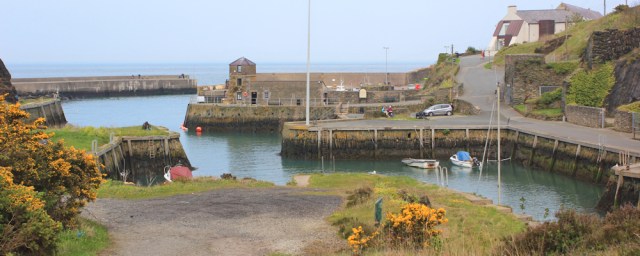
This was only a short walk because now I face a long drive back to Lincolnshire. Reluctant to leave, I stroll down one side of the inlet to the end, before retracing my steps and walking back to cross over the bridge and find my car.
Miles walked today = 9 miles
Wales Coast Path so far = 946 miles
Total distance around the coast: 2,453 miles
Route:


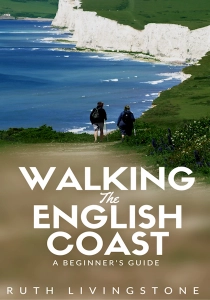




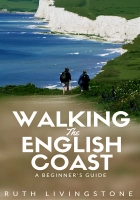
Looks like you had a lovely walk Ruth. The day I did this a local had warned us that it’s not a good idea to do the cliff path as it was too windy and they’d had a lot of heavy rain. We didn’t listen to him which was a big mistake, turned out to be a terrifying walk, the path was so wet and slippery, my sister fell over 3 times, the wind was blowing a gale so badly we had to come off and take a detour from the church as far too dangerous because the wind was blowing with such force. At one point the path had crumbled with a sheer drop on one side, my sister froze and I couldn’t get her to move, I crawled across the breach but she wouldn’t move, I found a way through the heather and got her to move that way. She hasn’t walked with me since ! Lol!!! Her words “NEVER AGAIN ” Amazing what difference bad weather can make. Much nicer to read your account. I however have leant always listen to the locals, well mostly ! 😊
Crikey Di. That sounds like a nightmare of a walk! What a difference the weather makes. This section was very rugged and I can imagine how difficult it would be in bad weather. I did notice some newly created steps on some of the steep bits, where I suspect the path had been repaired since you walked that way.
I think the young birds are ravens. Ravens re-use traditional nest sites year after year so the pile of sticks builds up like the one in your photo.
Your blog is fantastic – I feel I have travelled with you, enjoying revisiting areas I have walked and ‘discovering’ places I look forward to visting one day. Your balance of photos, both the attractive countryside and contrasting industrial architecture, and text seems just right. Eagerly wait for each next section.
Hi Jacquie and thank you very much for your kind words about my blog. Glad you enjoy reading it.
And thank you for the information about the ravens. Yes, I’m sure you’re right. Another coastal walker (Graham Jackson) walked this section a few days later and he suggested they were ravens too.
Best wishes, Ruth
Dear Ruth,
Three friends are doing something similar to what you’re doing ( except that they’ve missed out the coast of Wales, doing Offa’s Dyke instead) and one of them brought this to my attention as I hail from Amlwch. Even though I’ve lived away for many years, I know that part of the world well and really enjoyed your photos and your account. Thank you.
Photo 20 looks like a swimming pool in the sea. At high tide, it’s about 12 foot deep and a great place to swim. ( At low tide, there’s sand there.)
The next photo is industrial archaeology of a more recent vintage than the other bits you photographed. When we had lead in petrol, that’s one of the places they made it. ( I think “it” was bromide.) A company called Octel, previously Ethel, which I think was a joint venture between some major oil companies. It closed down 15 to 20 years ago and thankfully most of the old works have been pulled down as it was a bit of an eyesore on the headland.
I’ll bring your blog to the attention of family and friends who live in Anglesey and are Friends of the Coastal Path. I’m sure they’ll be interested in your account.
Enjoy the rest of your …….”walk” doesn’t do it justice. Trek or journey perhaps.
Alan
Hi Alan, and thank you taking the time to comment and provide all this information. Amlwch must have been a lovely place to grow up in. I see what you mean about the swimming pool. Interesting. And also interested in the history of the old industrial buildings. Mixed feelings: on the one hand it’s good to get rid of an eyesore, while on the other hand I’m shocked by how much industry has been lost from Wales.
Are your friends walking the entire English coast? Scotland too? Do they have a blog? One of us coastal walkers keeps a list of other coastal walkers, and we should add their names if they’re willing.
Best wishes, Ruth
I loved all the ruins you passed on this walk although it s sad so much industry has disappeared.
I have been shocked, quite frankly, during the Welsh and Cornish sections of my walk, to see how much we have lost and how badly these communities have suffered.
A great set of images from this walk Ruth, as others have said, a fascinating mix of natural and industrial landscape. Love the image of the young Ravens!
Thanks Theresa. If only I’d had my telephoto lens with me… but too heavy to carry around.